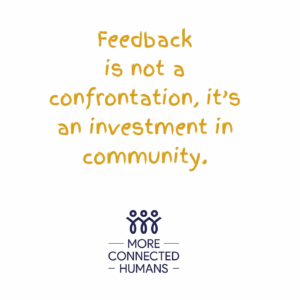In this moment in history, feedback feels rarer than it should.
For some, it lands like a blade — cutting and sharp. For others, the fear of inflicting harm keeps them silent. We’ve become cautious, and in that caution, something essential has been lost: the ability to engage in real-time exchange that deepens connection and sharpens self-awareness.
But feedback doesn’t have to be bad news. It isn’t inherently critical or harsh. When offered with care and clarity, it can illuminate a strength someone hadn’t yet recognized or gently point to a shift that could open new doors. It can affirm, clarify, and catalyze growth.
The real work isn’t just about offering or receiving feedback — it’s about building the emotional and intellectual resilience to do both with grace.
That means investing in self-regulation, trust, and presence. It means learning how to surround the feedback with spaciousness: making it observable, exploratory, and neutral enough to be useful.
Imagine what becomes possible when feedback is not a confrontation, but an invitation — one that says, “I see you. I want to connect more honestly with you. I trust you can hear this.”
That’s the kind of feedback culture we need — not only in workplaces, but in families, friendships, and movements.
Let’s reshape feedback culture together.
⸻
A Few Tips to Engage in Feedback with Care and Confidence
- Start with Permission
Ask if the other person is open to feedback. It builds psychological safety and gives them agency in the moment.
2. Lead with Curiosity, Not Judgment
Feedback is more effective when it’s framed as an observation, not an evaluation. Use phrases like “I noticed…” or “I wonder if…” to keep it open-ended and grounded in care.
3. Honor the History Behind the Reaction
For many, feedback isn’t just about the present moment — it can echo past experiences of criticism, rejection, or harm. Before diving in, acknowledge that feedback can feel tender.
You might say, “I know feedback can be hard to hear, and I’m offering this with care.”
Center the idea that people have different orientations to feedback, and our role is to create a supportive space for it to land.
4. Name the Impact, Not Just the Action
When possible, share how the behavior affected you or others — with empathy and clarity. Impact creates understanding, but it should be offered with kindness, not blame.
5. Include the Positive
Feedback isn’t just about what’s not working. Call out what is working — especially the things they may not realize they do well. Uplifting truths build confidence and connection.
6. Stay Regulated
Check your own tone, body language, and emotional state. If you’re feeling reactive, it’s okay to pause and return to the conversation when you’re grounded.
7. Welcome Feedback in Return
Ask, “How did that land?” or “Is there anything you’d like me to hear, too?”
This creates mutuality and models that feedback is a shared, living practice — not a power play.
8. Normalize Feedback as Everyday Practice
Make feedback a regular part of how your community or team functions — not something reserved for hard moments.
When feedback flows in all directions, it becomes a tool for growth, not correction.
Try using prompts like:
• “What went well?”
• “If we have time, what could have been done differently?”
• “For next time, what can I be thinking about to enhance the project?”
These questions gently normalize feedback, helping it feel safe, consistent, and useful.
⸻
Reflection Prompt for Leaders
When was the last time you offered or received feedback that led to a deeper connection?
What made that moment work — and what might you need to feel more supported in doing it again?

